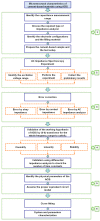Piezoresistivity and AC Impedance Spectroscopy of Cement-Based Sensors: Basic Concepts, Interpretation, and Perspective
- PMID: 36676505
- PMCID: PMC9865006
- DOI: 10.3390/ma16020768
Piezoresistivity and AC Impedance Spectroscopy of Cement-Based Sensors: Basic Concepts, Interpretation, and Perspective
Abstract
Cement-based sensors include conductive fillers to achieve a sensing capability based on the piezoresistivity phenomenon, in which the electrical resistivity changes with strain. The microstructural characterisation of cement-based sensors can be obtained using a promising non-destructive technique, such as AC impedance spectroscopy (ACIS), which has been recently used by many researchers. This paper reviews the fundamental concepts of piezoresistivity and ACIS in addition to the comparison of equivalent circuit models of cement-based sensors found in the literature. These concepts include piezoresistivity theory, factors affecting piezoresistivity measurement, resistance measurement methodology, strain/damage sensing, causes of piezoresistivity, theories of conduction, AC impedance spectroscopy theory, and the equivalent circuit model. This review aims to provide a comprehensive guide for researchers and practitioners interested in exploring and applying different techniques to self-sensing concrete.
Keywords: AC impedance spectroscopy (ACIS); cement-based sensors; equivalent circuit model; piezoresistivity; self-sensing concrete; structural health monitoring.
Conflict of interest statement
The authors declare no conflict of interest.
Figures















References
-
- Soh C.-K., Yang Y., Bhalla S. Smart Materials in Structural Health Monitoring, Control and Biomechanics. Springer; Berlin/Heidelberg, Germany: 2012. - DOI
-
- Khotiaintsev S., Beltrán-Hernández A., González-Tinoco J., Guzmán-Olguín H., Aguilar-Ramos G. Structural Health Monitoring of Concrete Elements with Embedded Arrays of Optical Fibers; Proceedings of the SPIE Smart Structures and Materials + Nondestructive Evaluation and Health Monitoring; San Diego, CA, USA. 10–14 March 2013.
-
- Klar A., Goldfeld Y., Charas Z. Measures for Identifying Cracks within Reinforced Concrete Beams Using BOTDR. SPIE; Bellingham, WA, USA: 2010.
-
- Goldfeld Y., Klar A. Damage Identification in Reinforced Concrete Beams Using Spatially Distributed Strain Measurements. J. Struct. Eng. 2013;139:4013013. doi: 10.1061/(ASCE)ST.1943-541X.0000795. - DOI
-
- Antunes P., Lima H., Alberto N., Bilro L., Pinto P., Costa A., Rodrigues H., Pinto J.L., Nogueira R., Varum H., et al. Optical Sensors Based on Fiber Bragg Gratings for Structural Health Monitoring. Volume 96. Springer; Berlin/Heidelberg, Germany: 2011. pp. 253–295.
Publication types
LinkOut - more resources
Full Text Sources

